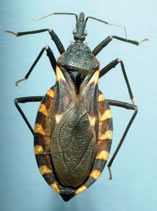 Conenose Bugs - July 6, 2005 Jeff Schalau, County Director, Associate Agent, Agriculture & Natural Resources Arizona Cooperative Extension, Yavapai County Conenose bugs (Triatoma sp.), also known as kissing bugs or Hualapai tigers, feed on the blood of mammals. Their primary hosts are rodents and most commonly wood rats (pack rats). They will also feed on human hosts when others are not available. They tend to be most common in foothill areas of mountains and on the edges of towns where woodrats are most abundant. Four species of conenose bugs occur in Arizona. They are between 3/4" and 1 1/4" long, usually dark brown with yellow or red markings. They may be distinguished by their characteristic long, cone-shaped nose when viewed from above. Many of the Hemipterans listed above somewhat resemble conenose bugs, so proper identification is important. Conenose usually feed when the host organism (you or your family in the absence of other more desirable hosts) is sleeping. Most people do not feel the bite of the conenose bug. Some people suggest that the bugs inject an anesthetic. To date, there is no direct evidence of this. They also move slowly and most often bite when the host is unaware. Upon biting, they inject an anticoagulant to stimulate blood flow. Conenose bug bites start to itch and leave swollen red spots one or two days after they occur. The red spots may persist for up to 30 days. Persons bit repeatedly by conenose bugs can experience an allergic reaction. Symptoms could include dizziness, nausea, itching on the scalp, palms, and soles of the feet. Swelling occurs around the eyes, tongue, larynx, and trachea. If you suspect that you have been bitten by a conenose bug and are experiencing an allergic reaction, call your local poison control center immediately (the Arizona Poison Control Center phone number is 520-626-6016). Conenose bugs fly from rodent burrows in late spring to early summer to search for new rodent burrows. They fly at night and are attracted to lights. This is most often the time when humans become acquainted with conenose bugs. They fly toward outdoor lighting or windows with light showing. If the home is not well screened and weather stripped, they gain entry to feed on humans and our pets. They also can move from rodents to human hosts when rodents are suddenly removed from the area. If you decide to remove a woodrat nest, be sure to treat it with an insecticide (as well as with a disinfectant to reduce the risk of Hanta virus). There are several steps to prevent conenose bugs from easily entering your home. In addition to weather stripping and otherwise sealing the home, you can: reduce the amount and duration of outdoor lighting; use shades or curtains on brightly lit windows; check bedding, furniture, and under beds; and in extreme cases, bed nets can be used. If you decide to use an insecticide, use a crack and crevice formula and treat any areas where conenose bugs could hide. Also, be cautious when camping to minimize risk of conenose bites. Donít camp near woodrat nests or caves when adults are active in the summer months. In Latin America, some species of conenose bugs transmit the organism that causes Chagasí disease. Two cases of Chagasí disease have been reported in southern Texas and one in central California. The Chagasí disease protozoan, Trypanosoma cruzi, that is transmitted by conenose bugs is excreted in their feces. If the fecal material is scratched into the bite or onto mucous membranes, it can enter the human body; therefore, always disinfect the bite site with iodine to prevent infection, and then wash it to remove fecal material. Latin American conenose bug species are more likely to defecate after feeding making the disease more common there. Symptoms include swelling of the face, high or moderate fever two weeks after being bitten, swelling of other body areas, and sometimes nervous disorders. If the patient recovers, chronic infection becomes established and may result in cardiac damage or other serious disorders and even death. The University of Arizona Cooperative Extension has publications and information on gardening and pest control. If you have other gardening questions, call the Master Gardener line in the Cottonwood office at 646-9113 ext. 14 or E-mail us at mgardener@verdeonline.com and be sure to include your address and phone number. Find past Backyard Gardener columns or submit column ideas at the Backyard Gardener web site: http://ag.arizona.edu/yavapai/anr/hort/byg/. |